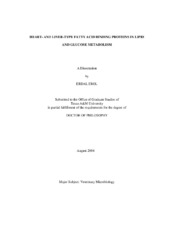| dc.description.abstract | Heart-type Fatty Acid-Binding Protein (H-FABP) is required for high rates of skeletal muscle long chain fatty acid (LCFA) oxidation and esterification. Here we assessed whether H-FABP affects soleus muscle glucose uptake when measured in vitro in the absence of LCFA. Wild type and H-FABP null mice were fed a standard chow or high fat diet before muscle isolation. With the chow, the mutation increased insulin-dependent deoxyglucose uptake by 141% (P<0.01) at 0.02 mU/ml of insulin, but did not cause a significant effect at 2 mU/ml insulin; skeletal muscle triglyceride and long chain acyl-CoA (LCACoA) levels remained normal. With the fat diet, the mutation increased insulin-dependent deoxyglucose uptake by 190% (P<0.01) at 2 mU/ml insulin, thus partially preventing insulin resistance, and completely prevented the threefold (P<0.001) diet-induced increase of muscle triglyceride levels; however, muscle LCACoA levels showed little or no reduction. With both diets, the mutation reduced the basal (insulinindependent) soleus muscle deoxyglucose uptake by 28% (P<0.05). These results establish a close relationship of FABP-dependent lipid pools with insulin sensitivity, and indicate the existence of a non-acute, antagonistic, and H-FABP-dependent fatty acid regulation of basal and insulin-dependent muscle glucose uptake.
Liver fatty acid binding protein (L-FABP) has been proposed to limit the availability of chain LCFA for oxidation and for peroxisome proliferator-activated receptor (PPAR-alpha), a fatty acid binding transcription factor that determines the capacity of hepatic fatty acid oxidation. Here, we used L-FABP null mice to test this hypothesis. Under fasting conditions, this mutation reduced β-hydroxybutyrate (BHB) plasma levels as well as BHB release and palmitic acid oxidation by isolated hepatocytes. However, the capacity for ketogenesis was not reduced: BHB plasma levels were restored by octanoate injection; BHB production and palmitic acid oxidation were normal in liver homogenates; and hepatic expression of key PPAR-alpha target (MCAD, mitochondrial HMG CoA synthase, ACO, CYP4A3) and other (CPT1, LCAD) genes of mitochondrial and extramitochondrial LCFA oxidation and ketogenesis remained at wild-type levels. These results suggest that under fasting conditions, hepatic L-FABP contributes to hepatic LCFA oxidation and ketogenesis by a nontranscriptional mechanism. | en |


